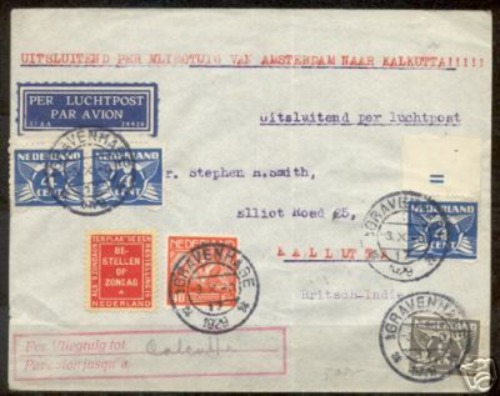
1929>
Pleasure flights
KLM started organising excursions by plane soon after it had been founded. Flights left from Schiphol and Waalhaven airports, offering many people their first bird's-eye view of Amsterdam and Rotterdam.
The number of aviation enthusiasts was growing steadily and this had two consequences: people became more familiar with aeroplanes, which were still a novel phenomenon at the time, and the 'pleasure flights' became an important source of income for the company.
The excursions were usually organised on Sundays and public holidays, when there was a lull in business traffic. Having completed a round trip, passengers received a 'flight certificate' to show off to family and friends.
During the mid 1920s the KLM also started organising excursions at smaller airfields, in Eelde, Eindhoven, Gilze-Rijen, Twente and Heemstede:
'The round trips, including those which depart from the flower-exhibition in Heemstede, are developing favourably. Almost without exception, we draw more than 100 aviation enthusiasts on any Sunday.
There seems to be a general tendency amongst the public to familiarise themselves with air transport. The propaganda we have made for flights to the East Indies will undoubtedly have played some part in this.'
Unfortunaltely, when smaller aircraft were used many enthusiasts went home disappointed: 'On each occasion only 4 or 5 people take to the air, which means that other enthusiasts often have to wait a long time.
Consequently, on more than one occasion we were unable to take everyone up, and many people, who had grown tired of waiting, left the airfield."
New series of tests
The success of the 1928 trial flights encouraged KLM to commence regular but experimental scheduled services every fortnight between The Netherlands and the Dutch East Indies. The first flight left on September 12th, 1929. A lot of people came to Schiphol this early morning to say goodbye to the crew, Smirnoff, Beekman and flight engineer Veenendaal. The journey took 12 days and was completed without any major problems. The last of this series of testflights started december 12th 1929 with the PH-AEO, piloted by Tepas and Pellens. |
|
Routemaps
This cover pictured a route map, "Luchtroute Amsterdam - London", showing a very detailed flying route down the coast and across the Channel to London. As the passenger flew from Shiphol, he could follow the progress of the airplane in detail along the coast and then from Calais across the "Kanaal" to Folkestone , across Kent to Croydon Airfield. The map folds out to 60 inches. The very bottom of the map is also pictured showing the area around Croydon; note the airfields which are destined to become famous ten years later, Biggin Hill and Kenley. The airfields are shown along the route in solid red. Good landing terrain spots are shown in lined squares; emergency landing areas which fit the "precautions" mentioned above. |
|
Croydon was the London airport in 1929 and it was London's first airport. Passengers checked in under an impressive glass dome in the art deco style departure hall. In 1929, KLM was flying the twin-engine Fokker F.VIII and the three-engine Fokker F.VIIb/3m equipped with Wright Whirlwind J-5 engined Fokkers F.VII were also used on this service. |
General KLM hints
As you boarded the Fokker at Shiphol, each passenger was given an information leaflet. This hand-out is covers the use of lifebelts, how to operate the "air tube" ventilation, emergency exits, communication with the pilot ("...through the door behind the pilot seat."), and general notes. Here are some of the "General Notes": "After running about 120 yards the machine almost imperceptibly rises from the ground. |
|
The machines are so stable that passengers can have every confidence and with such get quickly accustomed to the motion. It may interest passengers to know that the machines of the K.L.M. have proved their air worthiness and stability by flights across the Channel when the regular cross Channel steamers have been prevented from sailing owing to stormy weather. "Do not throw these receptacles out of the machine... |
KLM airguide
This 1929 airguide was divided into tabbed sections, covering not only the schedules and fares, but also sections on the aircraft, baggage, route maps (including one to India and Batavia) with photos and general passenger information. It had nicely drawn pen-and-ink sketches head several of the sections; all of the booklet was in Dutch with the exception of some English in advertisements. |
|











